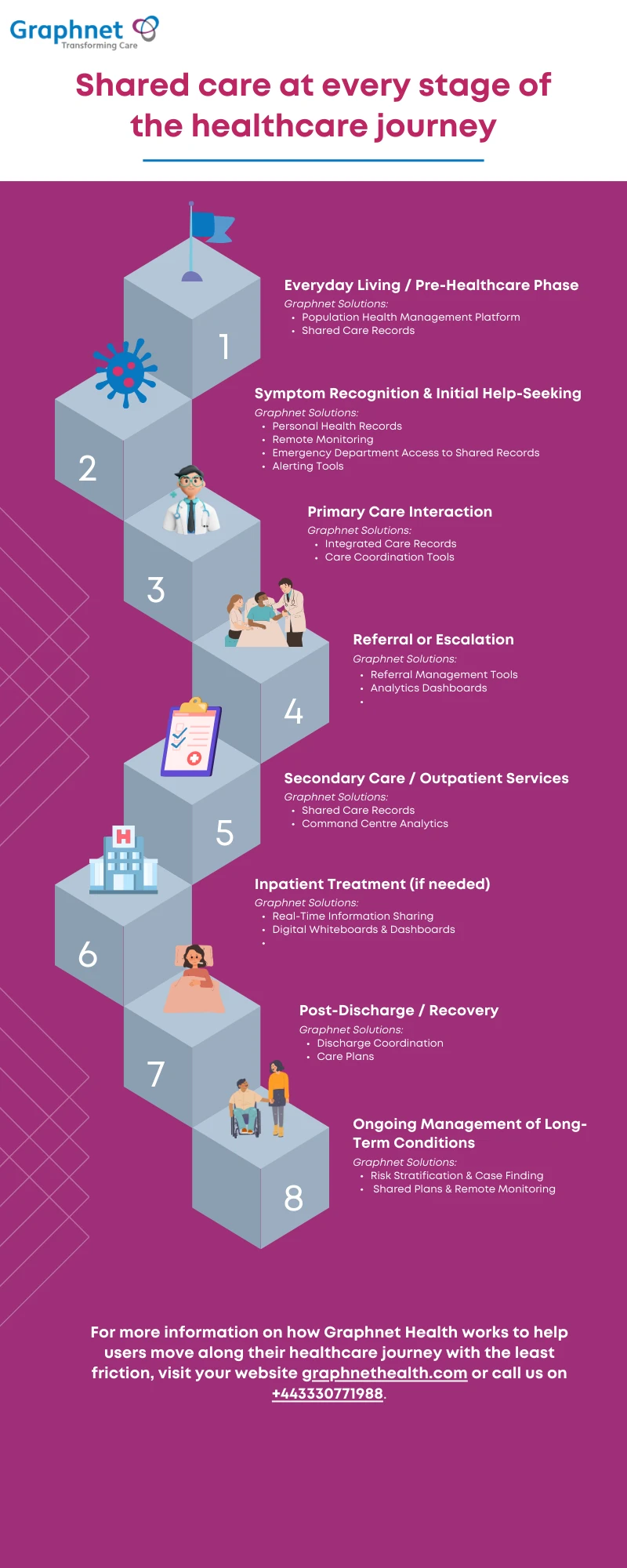Shared care at every stage of the healthcare journey
20 May 2025
Every healthcare journey is unique — from emergency calls and same-day discharges to years of ongoing care. The aim is always the same: make the experience smoother and more effective for both patients and professionals.
Shared care solutions are essential in joining up this journey, improving coordination, and delivering better outcomes.
The Healthcare Journey Mapped
Everyday Living / Pre-Healthcare Phase
Even before illness, individuals interact with healthcare — through prevention, education, and advice.
Touchpoints:
- Public health campaigns (e.g. flu jabs, smoke-free initiatives)
- Pharmacies for over-the-counter advice
- Self-help via websites or health apps
Graphnet Solutions:
Population Health Management Platform
- Proactive Care: Helps identify at-risk patients early to prevent hospital admissions.
- Smart Analytics: Enables targeted interventions using risk stratification and real-time data.
- Supports Health Equity: Integrates social care data to address inequalities and prevent crisis.
- Proven Impact: Used by ICSs to reduce admissions and GP visits, supporting system-wide decision-making.
- Unified Patient Records: Integrates data from hospitals, GPs, social care, mental health, and community services into a single, accessible record.
- Comprehensive Care Planning: Supports multi-agency collaboration with tools for assessments, alerts, referrals, and personalised care plans.
- Patient Empowerment: Provides patients with access to their health records and the ability to contribute information, promoting active participation in their own care.
- Proven Impact: Demonstrated benefits such as reduced hospital admissions, shorter waiting lists, and improved patient engagement.
Symptom Recognition & Initial Help-Seeking
When symptoms appear, the right guidance early can improve outcomes. This stage spans non-emergency and emergency help.
- Non-Emergency Touchpoints:
- NHS 111 (phone/online triage)
- Community pharmacies
- GP access (in-person, phone, app)
Graphnet Solutions:
Personal Health Records (PHR)
- Real-Time Access: Patients can securely view and update their health information via NHS Login on desktop or mobile devices.
- Personalised Health Management: Users can input personal details, emergency contacts, and health data, which care teams can access for tailored support.
- Integrated Health Tracking: The PHR syncs with wearable devices and health apps, allowing for comprehensive monitoring of vital signs and health metrics.
- Enhanced Care Coordination: By combining patient-entered data with professional records, the PHR facilitates proactive care and improved health outcomes.
Remote Monitoring (RPM)
- Hospital-Level Care at Home: Graphnet's Remote Monitoring enables patients to receive hospital-equivalent care in their own homes, reducing hospital admissions.
- Comprehensive Monitoring Tools: Supports a range of health conditions facilitating continuous patient monitoring and data sharing.
- Enhanced Patient Engagement: Patients can actively participate in their care by recording vital signs and symptoms via user-friendly apps and devices, promoting self-management and timely clinical interventions.
Emergency Touchpoints (Can occur at any point depending on deterioration):
- 999 ambulance services
- A&E departments
- Urgent Treatment Centres
Graphnet Solutions:
Emergency Department Access to Shared Records
ED clinicians can instantly view medications, mental health history, safeguarding info, and recent care details across services. This supports faster, safer decisions, reduces duplication, and improves care for complex patients.
Alerting Tools
Graphnet tools can send real-time alerts when high-risk patients attend A&E, notifying relevant teams (e.g. community, social, mental health). This enables quick follow-up, better coordination, and helps avoid unnecessary admissions.
Primary Care Interaction
Often the first ongoing relationship in healthcare, covering both acute and routine needs.
Touchpoints:
- GP appointments (in-person or virtual)
- Practice nurses for checks and immunisations
- Health visitors or midwives
Graphnet Solutions:
Information from various data feeds
Real-time access to hospital, social care, and mental health data during GP consultations
Care Coordination Tools
Helps practice staff manage care plans, referrals, and ongoing conditions across services
Referral or Escalation
When more specialised care is required, referrals ensure timely and appropriate escalation.
Touchpoints:
- GP referrals to specialists
- Diagnostic tests
- E-referral systems
Graphnet Solutions:
Referral Management Tools
Graphnet provides digital tools that enable efficient and timely referrals to secondary care services.
- Referrals are fully integrated with shared records, so all relevant clinical data, assessments, and history can be included automatically.
- This ensures that receiving clinicians have the full picture, improving triage speed, decision-making, and continuity of care.
Analytics Dashboards
The platform includes real-time analytics dashboards that track referral patterns, diagnostic delays, and workflow bottlenecks.
- These insights help system leaders and operational teams identify pressure points, reduce wait times, and optimise pathways across the wider health system.
Secondary Care / Outpatient Services
Includes diagnostics, specialist consultations, or short hospital stays.
Touchpoints:
- Specialist consultants
- Diagnostics (X-rays, MRIs)
- Allied Health Professionals (e.g. physios)
Graphnet Solutions:
Virtual Ward Solutions
Provides hospital-level care for patients in the comfort of their own home. Provides immediate care, reduces readmission and frees up bed space.
Command Centre Analytics
Delivers live dashboards and predictive insights on bed capacity, ED flow, discharges, and outpatient demand. Enables trusts to optimise resources, reduce delays, and improve patient flow across hospital services.
Inpatient Treatment (if needed)
For those requiring overnight or extended hospital stays.
Touchpoints:
- Admission to wards
- Surgery or treatments
- Nursing care and discharge planning
Graphnet Solutions:
Real-Time Information Sharing
Graphnet enables live access to patient records from across the health and care system, ensuring inpatient teams have the most up-to-date and complete picture at the point of care.
- Clinicians on the ward can instantly view GP records, recent investigations, community services involvement, and safeguarding alerts, even if the data originated outside the trust.
- This reduces the need for repeat tests or assessments, saves valuable time, and ensures continuity and safety of care throughout a patient's inpatient stay.
Elective Recovery Tools
Graphnet’s Elective Recovery Tool supports trusts to organise, prioritise and streamline patient care pathways, and can help:
- Reduce administrative burden by automating data validation and eliminating duplicate or outdated patient records.
- Monitor waiting list performance and track progress toward NHS recovery targets.
- Enhance patient communication by ensuring up-to-date contact details and status updates, reducing the likelihood of missed appointments or treatment delays.
Post-Discharge / Recovery
Leaving hospital begins a new phase of care — focused on recovery and preventing readmission.
Touchpoints:
- GP follow-ups
- Community nursing
- Social care or rehabilitation services
Graphnet Solutions:
Discharge Coordination
Integrated alerts and shared discharge plans ensure smooth handovers to community and primary care teams. Real-time updates enable timely follow-ups, helping reduce readmissions and support recovery at home.
Care Plans
Shared, up-to-date care plans are accessible across GPs, nurses, social care, and community services. This ensures coordinated, person-centred support through recovery and long-term care.
Managing Long-Term Conditions
Some journeys continue indefinitely — requiring ongoing care and community support.
Touchpoints:
- Integrated care teams
- Mental health services
- Support groups and repeat prescriptions
Graphnet Solutions:
Risk Stratification & Case Finding
- Comprehensive Data Integration: Graphnet centralises extensive health and social care data, enabling a data-driven approach to identify at-risk populations, predict future healthcare needs, and optimise resource allocation.
- Advanced Segmentation Tools: Utilising demographics, clinical factors, and healthcare utilisation patterns, Graphnet's analytics tools perform in-depth patient segmentation to support early intervention and prevention strategies.
- Cohort Mapping and Frailty Index: The platform supports the creation of standardised disease and wellness registries, including tools like the Electronic Frailty Index (eFI) for comprehensive stratification of elderly patients.
Shared Plans & Remote Monitoring
- Enable better support at home for conditions like diabetes, COPD, heart failure
- Provides tailored health insights, helping optimise treatment and condition management.
For more information on how Graphnet can help streamline a patient’s healthcare journey or make efficiency savings for NHS trusts and other healthcare professionals, contact us today.










